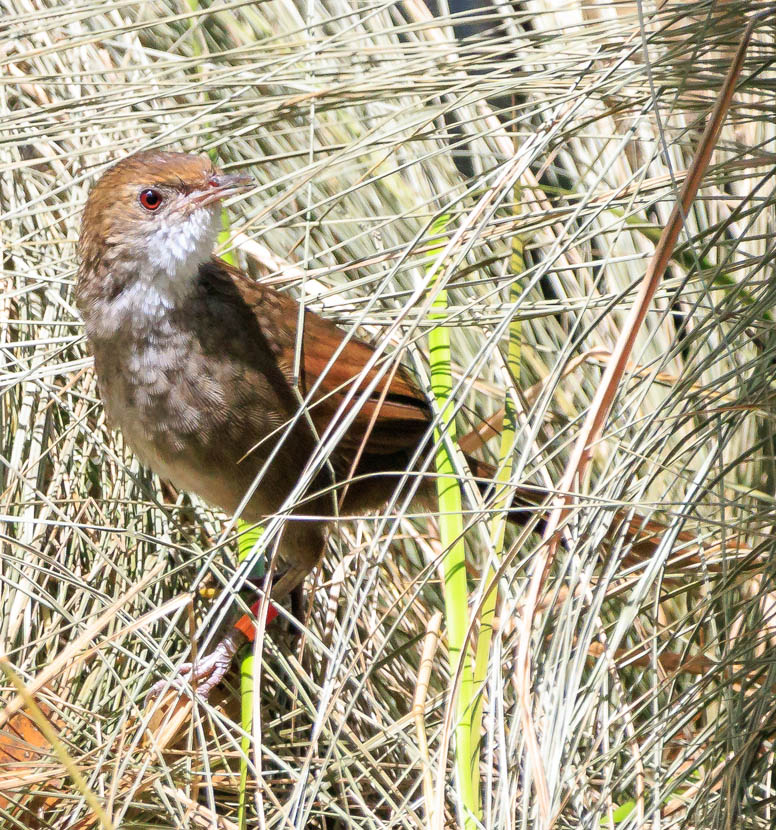Eastern Bristlebird
Conservation
The Eastern Bristlebird (Dasyornis brachypterus) is a small, cryptic, ground-dwelling bird that occupies low, dense heathland and grassy vegetation along the south-east coast of Australia. As a result of habitat loss and degradation, the once continuous distribution of the Eastern Bristlebird from Queensland to South Australia is now fragmented into three separate populations.
The northern population of the Eastern Bristlebird is one of 20 Australian threatened birds on the IUCN Red List of species threatened with extinction. Population monitoring has seen an 80% decline since the 1980s and this critically endangered northern population now comprises an estimated 38 wild birds.
This population is found only in south-eastern Queensland and north-eastern New South Wales and faces extinction in the wild from threatening processes such as habitat loss, grazing and predation.
Call of the wild
The Eastern Bristlebird is rarely seen but may be detected by its distinctive and loud call.
Protecting the Eastern Bristlebird in the wild
The conservation work for the Eastern Bristlebird in the wild includes habitat management to reduce the impact of weeds and feral predators on Eastern Bristlebird populations.
Fire management regimes in Eastern Bristlebird habitats are also crucial to ensure the grassy habitats are maintained for this species. Regular surveys are also conducted to monitor population trends.


Saving the Eastern Bristlebird through specialist care breeding
The Recovery Plan for the northern population of the Eastern Bristlebird includes a specialist care breeding program that is managed by Currumbin Wildlife Sanctuary.
The overall objective of the program is to have a sustainable population in specialist care that can support multiple reintroductions of Bristlebirds into the wild to supplement the wild northern population. This population in specialist care also acts as an insurance population against extinction.
Milestones & Achievements
2024

A total of 30 Eastern Bristlebirds have now been released, adding valuable genetics and numbers to the critically endangered northern population.
2023

15 Bristlebirds successfully released into prime wild habitat.
2022

First central x northern provenanced Bristlebird pair successfully bred at Garima Conservation Reserve. 5 breeding pairs of Eastern Bristlebird were transferred to the new breeding habitats at Garima Conservation Reserve
2021

Construction of 5 breeding habitats at Garima Conservation Reserve (a property managed by Currumbin Wildlife Sanctuary).
2020

First successful breeding of a central population provenanced Eastern Bristlebird at Currumbin Wildlife Sanctuary.
2019

Central population provenanced Eastern Bristlebirds collected from the wild and transferred to Currumbin Wildlife Sanctuary to increase genetic diversity in the specialist care breeding population.
2015

Northern Eastern Bristlebird eggs collected from the wild. These eggs were incubated and the chicks’ hand-reared at Currumbin Wildlife Sanctuary. This year Currumbin Wildlife Sanctuary also had our first northern Eastern Bristlebird chick successfully bred in specialist care!
2014

Currumbin Wildlife Sanctuary takes on the role of leading specialist care breeding of the northern Eastern Bristlebirds. Birds collected from the wild and the remaining birds in specialist care held at another institution were transferred to Currumbin Wildlife Sanctuary.
How can you help save the Eastern Bristlebird?
Purchase a Wish List Item
You can help by purchasing and donating a much- needed wish list item. From research equipment to food for Eastern Bristlebirds, every bit helps.
Donate
Help our conservation teams to continue saving these ground-dwelling birds with a Eastern Bristlebird donation.
Where will your donation go?

$20
will feed one Eastern Bristlebird for a week

$720
will help us capture live insects to feed the birds

$1,000
will buy feeding containers and equipment

$1,000
will purchase essential equipment for releases

$2,000
will buy native grasses to provide plant cover

$5,000
will pay for a lab technician to support the conservation team

Make a Difference
Make a tax-deductible donation today and it will go a long way for Conservation. We are so grateful for any donation, big or small!
Jingeri – Hello
We respectfully acknowledge the Traditional Custodians of the greater Yugambeh language region, the Country on which Currumbin Wildlife Sanctuary and Hospital are situated today. We recognise their continuing connections to the land, sky, waters (waterways), and wildlife. We thank them for caring for this Country and its ecosystems.
We celebrate Aboriginal and Torres Strait Islander cultures, and we pay our respect to Elders past and present.



